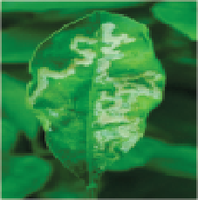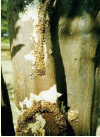Kinnow Insect Pests
Kinnow Insect Pests
Citrus leaf miner
Name : Phyllocnistis citrella Stainton
Family : Lepidoptera (Gracillariidae)
Description
 During nursery stage, leafminer is one of the limiting factors in producing healthy seedlings. It also continues to inflict serious damage even after transplanting. It generally occurs during spring (March-April) and autumn (September- October).
During nursery stage, leafminer is one of the limiting factors in producing healthy seedlings. It also continues to inflict serious damage even after transplanting. It generally occurs during spring (March-April) and autumn (September- October).- The citrus leaf miner adult is a tiny silvery-white moth about 2 mm long with fringed wings. Fore wings have brown stripes and a prominent black spot near the apical margin while hind wings are pure white with a wing spread of 4-5 mm. Adults can be seen on young flush leaves when disturbed.
- Eggs are laid singly usually on the underside of leaves near the midrib. The eggs look like tiny water droplets and hatch within 3-5 days.
- The young pale yellow larvae immediately start feeding between epidermal layers of the leaf. They pupate, when full grown, near the margin of the mined leaf.
- The total life cycle is about 2 - 3 weeks.
Damage symptoms
The characteristic symptom of leaf miner is presence of silvery serpentine mines usually on the under surface of the leaf. Usually each leaf has only a single mine, but in case of heavy infestation there may be several mines per leaf. This mining of the leaves causes them to curl up, distorted and thereby reducing the photosynthetic area of the young foliage. In case of severe infestation mines can also be seen on the upper side of the leaves as well as on shoot portion of new twigs. Damage by this pest predisposes the plant for development of canker disease.
Citrus psylla
Name : Diaphorina citri Kuwayama
Family : Hemiptera : Psylfidae
Description
 This pest is active on young flush during spring till autumn but the more serious damage is done during flowering and fruit set stage in March-April.
This pest is active on young flush during spring till autumn but the more serious damage is done during flowering and fruit set stage in March-April.- This tiny insect is 3-4 mm long, mottled brown in color, with transparent wings.
- The eggs of psyllids are bright yellow and deposited on unopened leaf buds.
- Early instar nymphs are green or dull orange and late instar nymphs are bright yellowish orange.
Damage symptoms
The damage is caused by both nymphs and adults by sucking the cell sap from the leaves, tender shoots and flowers causing curling of leaves, defoliation and drying of twigs. Nymphs secrete whitish crystalline honey dew which attracts the growth of fungus, adversely affecting the photosynthesis. This insect also transmits the citrus greening disease. In case of severe attack the leaf buds, flower buds and leaves may wilt and die.
Citrus whitefly
Name : Dialoeurodes citri (Ashmead)
Family : Hemiptera : Aleyrodidae
Description
 Whiteflies are distributed in all citrus growing areas. The adult is 1.5 mm long with white or greyish wings, pale yellow body and red constricted eyes. The nymphs are oval in shape, scale like, blackish with marginal bristle like fringes and are stationary. Large number of yellowish eggs (150 - 200) are laid on the lower surface of leaves which hatches in about 10 days.
Whiteflies are distributed in all citrus growing areas. The adult is 1.5 mm long with white or greyish wings, pale yellow body and red constricted eyes. The nymphs are oval in shape, scale like, blackish with marginal bristle like fringes and are stationary. Large number of yellowish eggs (150 - 200) are laid on the lower surface of leaves which hatches in about 10 days.
Damage symptoms
The crawlers settle on the under surface of the leaves and suck the sap. These nymphs and adults suck the plant sap and secrete honeydew due to which sooty mould develops on the leaves. Severe infestation results in black layer manifestation, covering entire plant parts including fruits due to which photosynthesis is effected.
Citrus blackly
Name : Aleuracanthus woglumi Ashby
Family : Hemiptera : Aleyrodidae
Description
 The adults of backfly are ashy coloured with brick red abdomen, smoky wings.. The adult females are about 1.2 mm long and the males are 0.8 mm in length. The nymphs are scale like, shiny black and spiny with marginal fringes. The adults emerge in March-April and the females lay yellowish brown oval shaped eggs which are arranged in a spiral manner on broad leaves with 15-22 eggs in a cluster. The eggs hatch in 7-14 days and the nymphs on emergence start feeding on cell sap and settle on the lower side of the leaf. There are two distinct broods in a year. The first brood adults emerge in March-April and those of the second brood emerge in July-October.
The adults of backfly are ashy coloured with brick red abdomen, smoky wings.. The adult females are about 1.2 mm long and the males are 0.8 mm in length. The nymphs are scale like, shiny black and spiny with marginal fringes. The adults emerge in March-April and the females lay yellowish brown oval shaped eggs which are arranged in a spiral manner on broad leaves with 15-22 eggs in a cluster. The eggs hatch in 7-14 days and the nymphs on emergence start feeding on cell sap and settle on the lower side of the leaf. There are two distinct broods in a year. The first brood adults emerge in March-April and those of the second brood emerge in July-October.
Damage symptoms
Both adults and nymphs suck plant sap and results in the curling of leaves and also the premature fall of flower buds and the developing fruits thereby resulting in reducing the vitality of the tree. Moreover, honey dew secretion favours rapid development of black sooty mould that covers entire plant surface. The process of photosynthesis is hampered greatly resulting in stunted growth of plants, low intensity of flowering and scarce fruiting.
Citrus Aphid
Name : Toxoptera aurantii, Myzus persicae Sulzer, Aphis gossypii Glove
Family : Hemiptera : Aphididae
Description
 Three species of aphids, Toxoptera aurantii (Boyer de Fonscolombe); Aphis gossypii Glover and Myzus persicae (Sulzer) in general are sporadic pests, but now these are becoming regular pests of citrus. T.aurantii and A. gossypii are reported as most efficient vectors of Citrus Tristeza Virus (CTV).
Three species of aphids, Toxoptera aurantii (Boyer de Fonscolombe); Aphis gossypii Glover and Myzus persicae (Sulzer) in general are sporadic pests, but now these are becoming regular pests of citrus. T.aurantii and A. gossypii are reported as most efficient vectors of Citrus Tristeza Virus (CTV).
Aphids are soft bodied, pear shaped, tiny sucking insects, measuring less than 2 mm in length and are pale yellowish green to black in colour. They have apair of cornicles arishing from Vth abdominal segment. Each aphid produces about 5 young nymphs/ day for a period of 1-3 weeks parthenogenetically Single live cycle normally takes 6 to 8 days.
Damage symptoms
Nymphs and adults suck sap from tender leaves and shoots. Affected leaves turn yellow, ger curled, deformed and dry up. Growth of young shoots is adversely affected. Plant growth is stunted. Sooty mould is produced on honeydew excreted by aphids. Infestation of aphids at the time of flowering is associated with reduced fruit set. Aphids also act as the active vectors of Citrus Tristeza Virus.
Citrus fruit sucking moth
Name : Eudocima fullonica Linnaeus
Family : Lepidoptera Noctuidae
Description
The moths are distinguished by having particularly well developed proboscis with dentate tips with which they are able to pierce the ripening fruits. The adults of E.fallonica have pale orange brown body with forewings dark grayish and the hind wings orange red with two black curved patches. The female moth lays eggs on weeds like Tinospora cardifolia, T.semilacina, Cocculus hirsutus, Convolvulus arvensis etc. where the caterpillar develops after harching. Egg period is 8-10 days. The caterpillar is a semilooper, dark brown with yellow and red spots. Full grown caterpillars are 50-60 mm long, stout, velvety-blue with yellow patterns on dorsal and lateral sides. pupation takes place in a transpatent pale whitish silken cover enclosed in leaf fold. Larval period is 28-35 days. Pupal period is 14-18 days.
Symptoms
It is a pest of regular occurrence on maturing kinnow fruits during July-October in Hoshiarpur and Gurudaspur districts of Punjab in the recent past. These moths are active during night and suck the juice from the fruit with their long proboscis. The punctures produced during feeding by the adult moths leads to fruit rot due to invasion by secondary pathogens leading to pre-mature fruit drop. Only adult moths are destructive to citrus fruits.
Bark eating caterpillar
Name : Indarbela quadrinotata (Walker)
Family : Lepidoptera: Metarbelidae
Description
 The pest is noticed predominantly in old and neglected orchards. The hanging wooden frass and tunnel at the joint of two branches from October-April indicates the presence of the pest. Adult moths are active during May-June. They are 35-40 mm in size, pale brown or grey in colour. Female moths deposit eggs under loose bark and eggs hatch in 8-10 days. Caterpillars are 50-60 mm and have pale brown bodies with dark brown heads.
The pest is noticed predominantly in old and neglected orchards. The hanging wooden frass and tunnel at the joint of two branches from October-April indicates the presence of the pest. Adult moths are active during May-June. They are 35-40 mm in size, pale brown or grey in colour. Female moths deposit eggs under loose bark and eggs hatch in 8-10 days. Caterpillars are 50-60 mm and have pale brown bodies with dark brown heads.
Damage symptoms
Caterpillars eat the bark and bore inside the tree. Larva remains hidden inside the tunnel during day time and becomes active in the night. Several caterpillars may attack the same tree at different locations which can cause serious injury to the bark and the death of small branches. The holes left on the trunk may lead to infestation by other insects or plant pathogens. Affected branches break at the points of attack. A severe infestation may arrest the growth of the tree and the fruiting capacity.
Citrus mite

Name : Eutetranychus orientalis Klein
Family :(Acarina)
Description
The adult is small, pulump and orange with thick deep brown patches on the dorsal side of its body and measures 0.33 mm in length. Its body is covered with prominent bristles, each borne on a whitish tubercle. The mites are most active during May-June when they lay about 50 eggs are minute, round and orange and are embedded in the leaf tissues, They hatch in about week. The newly hatched larva is light yellowish brown and has only three pairs of legs and after feeding on call sap for three or four days, it moults into protonymph which has four pairs of legs. It is full-fed in 4-5 days and after moulting, transforms into an adult mite. The female mites live for about ten or more days. The life - cycle in summer is completed in 17-20 days and the pest passes through several overlapping generations in a year.
Damage symptoms
The mite assumes serious proportions during dry spells particularly May-June in citrus orchards. In Punjab, it is found infesting kinnow, sweet-orange, lemon, grapefruit and sour-lime. Nymphs and adults cause damage by lacerating the leaves, resulting in speckled appearance of the leaves. Heavy infestation may result in complete defoliation, especially of the young nursery plants. The affected fruits become yellow and remain undersized.
Source: NCIPM
Last Modified : 4/1/2020
This topic provides information about Loquat Inse...
This topic covers information about Amla Insect Pe...
This topic covers the information related to Insec...
This topic covers information about Description of...
